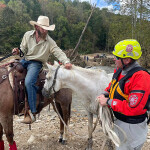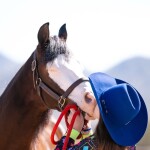Three-legged lame. Dead lame. Moving a little off. These are phrases no horse person ever wants to hear. But if you own horses long enough, you will hear them. Lower limb injuries can be mild to severe, have a long list of causes, and an equally long list of treatment modalities. A little preparation ahead of the need will give you peace of mind when you have to face caring for a lame horse.
As with every aspect of keeping horses, it is essential to establish a baseline normal for each horse. Taking note of the horse’s normal way-of-going will help you detect changes in movement. Do a regular visual and physical exam of your horse’s legs. Check for swelling, bumps, or heat. Some horses are quite stoic and will not show the level of pain they’re experiencing. Observing the horse daily and knowing the horse’s “normal” will allow you to quickly find problems.
“An ounce of prevention…” It’s true of all athletes. Properly conditioning your horse for the job will help to prevent soft tissue injuries. When muscles fatigue there is an increased risk of tendon and ligament injury. Careful warm-up and cool-down are essential parts of conditioning as well. Strengthening muscles and the cardiovascular system through various exercises, cross-training, nutrition, and hoof care are essential parts of preparing your horse to be safe and successful at its job.
It takes a village. Gathering a team of experts to assess the injury and formulate a rehabilitation plan is key to a quick and full recovery. A diagnostic veterinary exam early after onset of lameness can pinpoint the injury and hopefully prevent further damage. It may be necessary to enlist help at the barn to treat the horse during times you cannot be there. Know ahead of time who can help assist you in your horse’s care if your horse becomes lame.
Inflammation is the enemy. In the first three weeks after a soft tissue injury, the goal is to reduce inflammation. Ice or cold-hosing for 15 minutes at a time, several times a day as recommended by your veterinarian to help bring down inflammation. Your horse may need to be confined to stall rest, anti-inflammatory medications, and bandages. Leg wraps should be a part of the First Aid supplies in your barn. Injuries can often times occur after hours or when vet clinics and farm supply stores are closed.
Three weeks after onset to injury is when the healing process begins. Depending on the area where you live, there are many treatments available for soft tissue injuries. Controlled exercise is often the first therapy and can be supported with shock wave treatment, cold laser, underwater treadmill, and functional electrical stimulation. Regenerative medicine therapies include platelet-rich plasma, autologous protein solution or bone marrow aspirate injections. These relatively new therapies harness the horse’s own power to heal, combined with high-tech devices. A specially trained veterinarian will draw a small amount of your horse’s blood, run it through a specific device depending on which treatment is needed. This medical device concentrates the horse’s healing cells which the vet then injects back into the injured area. Both soft tissue and joint injuries can be treated this way. Dr. Liberty Getman, Equine Technical Services Veterinarian, Zoetis, says, “the goal of regenerative medicine therapy is to restore the injured area to as near normal tissue composition as possible by isolating and concentrating the horse’s self-healing properties.”
Horses are designed to move. Unless your horse is 5 out of 5 lame, your vet may encourage hand-walking. Movement helps blood and lymph flow which will help increase healing. Walking provides stretching to the soft tissues and helps keep the hooves sound. A stalled, injured horse is more prone to laminitis. Your veterinarian will set-up an exercise schedule based on the severity of the initial injury and the progress your horse makes with treatment. Keeping a written list of medications, treatments, and exercise protocol at your horse’s barn will ensure all his therapies are delivered on-time and correctly.
Some horse owners choose to send injured horses to an in-patient facility for rehabilitation. There are equine rehabilitation centers across the country that provide advanced treatments in their facility. KESMARC (Kentucky Equine Sports Medicine and Rehabilitation Center) in Versailles, KY is a leader in rehabilitation services providing cutting-edge therapies supported by top veterinary clinics. Your local veterinary clinic may also provide advanced therapies.
Early, aggressive treatment will start your horse on the road to recovery. With dedication to his treatment, patience on your part, and a good dose of time, your equine athlete will hopefully have a full recovery and return to work after proper rehabilitation.









